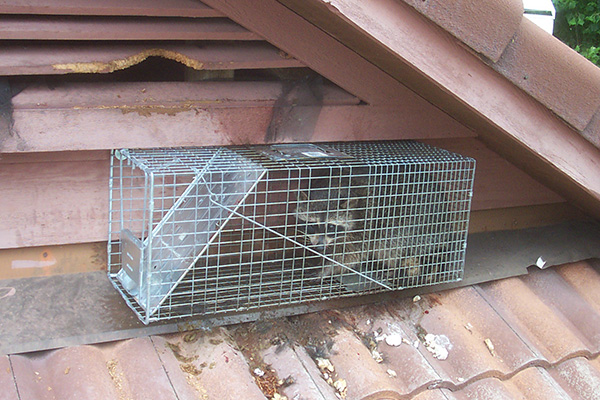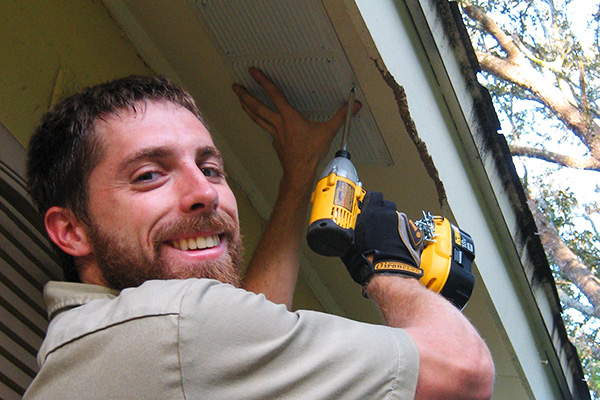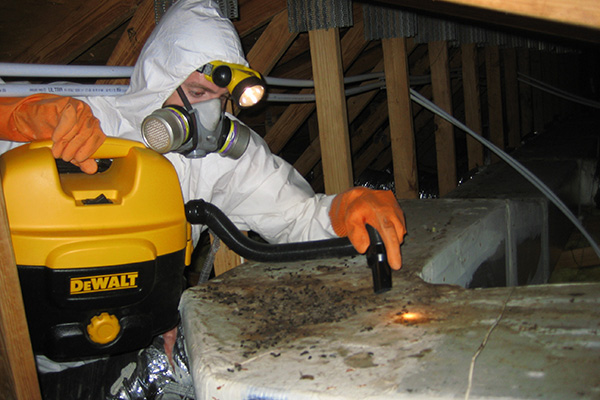- info@animalatticpest.com
- Call - we service 300 locations

Equipment - What Tools Are Needed
Inspection Tools: First and foremost is a good ladder which allows you access to the roof and all the eaves and other high areas animals use to enter the house. The size of ladder you need will depend on the
height of your house. A 24-foot ladder works in most 2-story situations, or a 12-foot ladder for a single-story home, but I break out my 32-foot and even my 40-foot ladder regularly for larger buildings. You may also need a
stepladder to get into the attic. Next, you'll want a headlamp when you inspect inside the attic. Add other attic safety equipment such as a filter mask, preferably a HEPA rated one, which filters out airborne animal
waste and insulation fibers. I also like to wear a disposable Tyvek suit, as well as a good pair of gloves.
Repair Tools: You must use good tools and materials. You should seal all holes with metal screen or metal flashing. Otherwise, animals will simply chew their way back in. Wood repairs aren't good enough, and
materials like caulk or expanding foam sealant certainly won't suffice. A power screwdriver is vital to bolt in your repairs with screws, not nails or glue. You want strong repairs. I often use a 90-degree
power screw to fit into tight areas. For most repairs, metal flashing is a great repair material, as is steel screen, also known as hardware cloth. You'll also need a good set of metal shears to cut the sheet metal flashing
or steel screen. You might want to buy specialty materials such as metal vent covers or a steel chimney cap for specific areas like a soffit vent or chimney flu. Read about Animals In The Chimney.
Trapping Tools: You'll need to either trap or exclude the animals. For larger animals like raccoons or possums, you want a large, sturdy steel cage trap, at least 12x12x30" in size. You'll also need something like a pillowcase
or bucket to hold the baby animals in. For squirrels, you'll want a smaller cage trap, like a 5x5x18 size. Or better yet, a special repeater trap that you mount over the squirrel hole, or a best of all, a one-way exclusion door to
allow the animals out, but not back in. For rats, you'll want to use the wooden Victor brand snap traps with the yellow pan. The same goes for mice, except you want the mouse-size traps. For bats, you'll need exclusion funnels or
netting.
Cleaning Tools: You'll want good protection, such as the above mentioned Tyvek suit and HEPA mask and gloves. If removing nesting material or large droppings by hand, you'll of course want plastic bags to store the waste in. Next,
a special enzyme-based cleaner which breaks down and neutralizes organic waste. Apply it with an electric atomizer sprayer,
which fogs the attic with a fine mist. You want either a small vacuum to vacuum up the smaller droppings, or a special industrial insulation vacuum if you are doing full insulation removal.
Equipment - What Tools Are Needed
Information About Equipment - What Tools Are Needed
It can be incredibly tempting to try to get wildlife out of your attic by yourself, but this process ends up being more of a challenge than the average homeowner can handle. Just one of the challenges you will face is finding all the equipment necessary to inspect your home and remove the animals from your attic. While you likely have some basics, like a ladder, around, other items are very specific to the industry. The average homeowner won’t have these things, but a professional will.
Tools For Evaluating
The first group of tools that you will need are for the inspection itself. As mentioned, you will need a ladder so you can reach all the necessary areas. If the animals are living in your roof, their entry points are most likely high up in your home and require a ladder to reach. You will also need a flashlight or headlamp to see clearly and be able to spot all of the holes that could serve as entrances.
Tools For Removal
You will also need a reasonable amount of equipment for the actual removal, whether you choose to trap and relocate or exclude. Those who want to exclude the animals from their roof will need a one-way door or exclusion device along with the materials necessary to securely mount it, such as a hammer and nails or screws and a screwdriver. If you plan on trapping, you will need to have a trap of the appropriate size for the animal in question.
Squirrels and opossums, for example, require very differently sized traps and the item you use for one won’t work for the other animal. Traps that are too small will not catch the animal or cause injuries while those that are too large may allow them to escape or injure themselves by running around inside. Sometimes, you may want a repeater trap so you can catch multiple animals at once. This is particularly useful if you have a colony of squirrels or a similar situation in your attic and don’t want to use exclusion.
In addition to the traps themselves, you will need the items that accompany them. This includes bait to attract the animals in question. Although you may not think about it, you will also want a tarp, cloth, or something similar to cover the trap when transporting the animal as a way to keep it calm.
Tools For Repairs And Cleanup
The other major category of equipment needed to inspect your home and remove the animals are those required for repairs as well as cleanup. You will need to begin by repairing all of the holes in the exterior of your home that allowed the animals to get inside. These will typically be average home construction materials, but you should opt for the sturdiest version possible. Consider steel mesh or plates along with sturdy bolts and screws.
After the animals have been removed and the cleanup efforts begin, you need to conduct another category of repairs. Depending on the damage done, you may find yourself in need of wood to replace boards in your attic, insulation to use for replacement, or drywall to patch holes in the wall.
There are also the actual cleaning supplies, including a strong disinfectant. Ideally, you will want to use an enzymatic cleaner as this will break down the bacteria and disease-causing agents as well as smells. You should also have a fogging machine or something similar that converts this cleaner into a spray as that is the most effective way to reach every area of the attic. Of course, you will also need basic cleaning supplies like disposable rags, bleach, and garbage bags. A strong vacuum can also be useful for cleaning up droppings.
Protective Equipment
The last but perhaps most important set of tools you will need is protective gear. Even if you don’t come in direct contact with the animals in your attic, you are at risk of disease. At the minimum, you should always wear a pair of sturdy gloves and a face mask. During the cleaning process, you will want to have full body protective gear as well. This is the best way to ensure you don’t come in contact with disease-causing agents.
Where To Get The Equipment
Part of the challenge of removing animals from your attic yourself is that you are unlikely to have all the necessary tools on hand. You can get the basics for home repairs at a local hardware store but will then have to order traps or exclusion devices you only (hopefully) use once, which can be expensive. Some of the cleanup equipment, like fogging machines, can also be expensive. It ends up being much simpler and financially savvy to just hire a professional to take care of everything for you instead of buying the equipment and letting it gather dust in your garage.
The Bottom Line
You're only as good as your tools! Use quality equipment, and use the right tool for the job!




